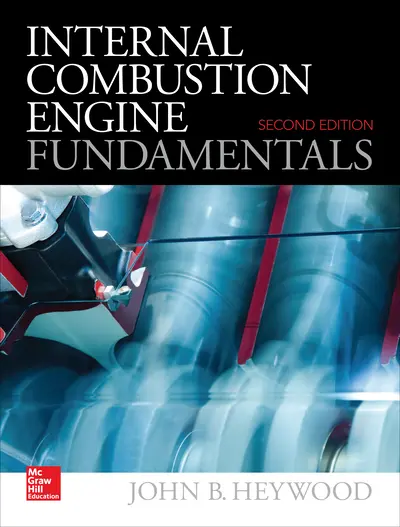My Account Details

ISBN10: 1260116107 | ISBN13: 9781260116106

* The estimated amount of time this product will be on the market is based on a number of factors, including faculty input to instructional design and the prior revision cycle and updates to academic research-which typically results in a revision cycle ranging from every two to four years for this product. Pricing subject to change at any time.
Instructor Information
Quick Actions (Only for Validated Instructor Accounts):
Publisher's Note: Products purchased from Third Party sellers are not guaranteed by the publisher for quality, authenticity, or access to any online entitlements included with the product.
The long-awaited revision of the most respected resource on Internal Combustion Engines --covering the basics through advanced operation of spark-ignition and diesel engines.
Written by one of the most recognized and highly regarded names in internal combustion engines this trusted educational resource and professional reference covers the key physical and chemical processes that govern internal combustion engine operation and design. Internal Combustion Engine Fundamentals, Second Edition, has been thoroughly revised to cover recent advances, including performance enhancement, efficiency improvements, and emission reduction technologies. Highly illustrated and cross referenced, the book includes discussions of these engines’ environmental impacts and requirements. You will get complete explanations of spark-ignition and compression-ignition (diesel) engine operating characteristics as well as of engine flow and combustion phenomena and fuel requirements.
Coverage includes:
• Engine types and their operation
• Engine design and operating parameters
• Thermochemistry of fuel-air mixtures
• Properties of working fluids
• Ideal models of engine cycles
• Gas exchange processes
• Mixture preparation in spark-ignition engines
• Charge motion within the cylinder
• Combustion in spark-ignition engines
• Combustion in compression-ignition engines
• Pollutant formation and control
• Engine heat transfer
• Engine friction and lubrication
• Modeling real engine flow and combustion processes
• Engine operating characteristics
CHAPTER 1 Engine Types and Their Operation
1.1 Introduction and Historical Perspective
1.2 Engine Classifications
1.3 Engine Operating Cycles
1.4 Engine Components
1.5 Multicylinder Engines
1.6 Spark-Ignition Engine Operation
1.7 Different Types of Four-Stroke SI Engines
1.7.1 Spark-Ignition Engines with Port Fuel Injection
1.7.2 SI Engines for Hybrid Electric Vehicles
1.7.3 Boosted SI Engines
1.7.4 Direct-Injection SI Engines
1.7.5 Prechamber SI Engines
1.7.6 Rotary Engines
1.8 Compression-Ignition Engine Operation
1.9 Different Types of Diesel Engines
1.10 Two-Stroke Cycle Engine Operation
1.11 Fuels
1.11.1 Gasoline and Diesel
1.11.2 Alternative Fuels
Problems
References
CHAPTER 2 Engine Design and Operating Parameters
2.1 Important Engine Characteristics
2.2 Geometrical Relationships for Reciprocating Engines
2.3 Forces in Reciprocating Mechanism
2.4 Brake Torque and Power
2.5 Indicated Work per Cycle
2.6 Mechanical Efficiency
2.7 Mean Effective Pressure
2.8 Specific Fuel Consumption and Efficiency
2.9 Air/Fuel and Fuel/Air Ratios
2.10 Volumetric Efficiency
2.11 Specific Power, Specific Weight, and Specific Volume
2.12 Correction Factors for Power and Volumetric Efficiency
2.13 Specific Emissions and Emissions Index
2.14 Relationships between Performance Parameters
2.15 Engine Design and Performance Data
2.16 Vehicle Power Requirements
Problems
References
CHAPTER 3 Thermochemistry of Fuel-Air Mixtures
3.1 Characterization of Flames
3.2 Ideal Gas Model
3.3 Composition of Air and Fuels
3.4 Combustion Stoichiometry
3.5 The First Law of Thermodynamics and Combustion
3.5.1 Energy and Enthalpy Balances
3.5.2 Enthalpies of Formation
3.5.3 Heating Values
3.5.4 Adiabatic Combustion Processes
3.5.5 Combustion Efficiency of an Internal Combustion Engine
3.6 The Second Law of Thermodynamics Applied to Combustion
3.6.1 Entropy
3.6.2 Maximum Work from an Internal Combustion Engine and Efficiency
3.7 Chemically Reacting Gas Mixtures
3.7.1 Chemical Equilibrium
3.7.2 Chemical Reaction Rates
Problems
References
CHAPTER 4 Properties of Working Fluids
4.1 Introduction
4.2 Unburned Mixture Composition
4.3 Gas Property Relationships
4.4 A Simple Analytic Ideal Gas Model
4.5 Thermodynamic Property Charts
4.5.1 Unburned Mixture Charts
4.5.2 Burned Mixture Charts
4.5.3 Relation between Unburned and Burned Mixture Charts
4.6 Tables of Properties and Composition
4.7 Computer Routines for Property and Composition Calculations
4.7.1 Unburned Mixtures
4.7.2 Burned Mixtures
4.8 Transport Properties
4.9 Exhaust Gas Composition
4.9.1 Species Concentration Data
4.9.2 Equivalence Ratio Determination from Exhaust Gas Constituents
4.9.3 Effects of Fuel/Air Ratio Nonuniformity
4.9.4 Combustion Inefficiency
Problems
References
CHAPTER 5 Ideal Models of Engine Cycles
5.1 Introduction
5.2 Ideal Models of Engine Processes
5.3 Thermodynamic Relations for Engine Processes
5.4 Cycle Analysis with Ideal Gas Working Fluid with cv and cp Constant
5.4.1 Constant-Volume Cycle
5.4.2 Limited- and Constant-Pressure Cycles
5.4.3 Cycle Comparison
5.5 Fuel-Air Cycle Analysis
5.5.1 SI Engine Cycle Simulation
5.5.2 CI Engine Cycle Simulation
5.5.3 Results of Cycle Calculations
5.6 Overexpanded Engine Cycles
5.7 Availability Analysis of Engine Processes
5.7.1 Availability Relationships
5.7.2 Entropy Changes in Ideal Cycles
5.7.3 Availability Analysis o
Need support? We're here to help - Get real-world support and resources every step of the way.